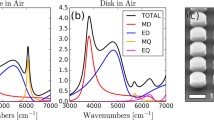Abstract
In this paper, we numerically study a new type of infrared resonator structure, whose unit cell consists of paired split-ring resonators (SRRs). At different resonant frequencies, the magnetic dipoles induced from the two SRRs within one unit cell can be parallel or antiparallel, which are defined as symmetric and antisymmetic modes, respectively. Detailed simulation indicates that the symmetric mode is due to magnetic coupling to resonators, in which the effective permeability could be negative. However, the antisymmetric mode originating from strong electric coupling may contribute to negative effective permittivity. Our new electromagnetic resonators with pronounced magnetic as well as electric responses could provide a new pathway to design negative index materials (NIMs) in the optical region.
Similar content being viewed by others
References
V.G. Veselago, Sov. Phys. Uspekhi 10, 509 (1968)
R.A. Shelby, D.R. Smith, S. Schultz, Science 292, 77 (2001)
D.R. Smith, W.J. Padilla, D.C. Vier, S.C. Nemat-Nasser, S. Schultz, Phys. Rev. Lett. 84, 4184 (2000)
T.J. Yen, W.J. Padilla, N. Fang, D.C. Vier, D.R. Smith, J.B. Pendry, D.N. Basov, X. Zhang, Science 303, 1494 (2004)
C. Enkrich, M. Wegener, S. Linden, S. Burger, L. Zschiedrich, F. Schmidt, J.F. Zhou, T. Koschny, C.M. Soukoulis, Phys. Rev. Lett. 95, 203901 (2005)
J.B. Pendry, Phys. Rev. Lett. 85, 3966 (2000)
N. Fang, H. Lee, C. Sun, X. Zhang, Science 308, 5721 (2005)
J.B. Pendry, A.J. Holden, D.J. Robbins, W.J. Stewart, IEEE Trans. Microw. Theory Technol. 47, 2075 (1999)
G. Dolling, C. Enkrich, M. Wegener, J.F. Zhou, C.M. Soukoulis, S. Linden, Opt. Lett. 30, 3198 (2005)
A.N. Grigorenko, A.K. Geim, H.F. Gleeson, Y. Zhang, A.A. Firsov, I.Y. Khrushchev, J. Petrovic, Nature 438, 335 (2005)
P. Nordlander, C. Oubre, E. Prodan, K. Li, M.I. Stockman, Nano Lett. 4, 899 (2004)
D.R. Smith, S. Schultz, P. Markos, C.M. Soukoulis, Phys. Rev. B 65, 195104 (2002)
T. Koschny, P. Markos, E.N. Economou, D.R. Smith, D.C. Vier, C.M. Soukoulis, Phys. Rev. B 71, 245105 (2005)
D. Schurig, J.J. Mock, D.R. Smith, Appl. Phys. Lett. 88, 041109 (2006)
Author information
Authors and Affiliations
Corresponding author
Additional information
PACS
78.20.Ci; 73.20.Mf; 42.25.Bs
Rights and permissions
About this article
Cite this article
Liu, Y., Fang, N., Wu, D. et al. Symmetric and antisymmetric modes of electromagnetic resonators. Appl. Phys. A 87, 171–174 (2007). https://doi.org/10.1007/s00339-006-3837-0
Received:
Accepted:
Published:
Issue Date:
DOI: https://doi.org/10.1007/s00339-006-3837-0




